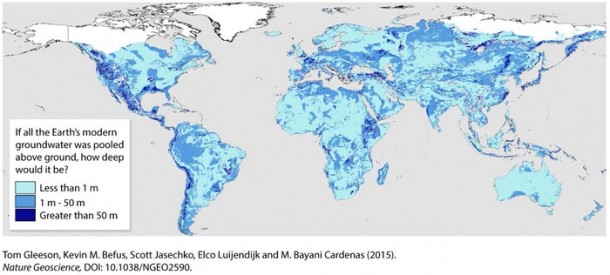Latest study has, for the first time, estimated the total volume of groundwater that is present on the Earth and the results are not too promising. In a nutshell; we are using up water supply much faster than it can be replaced naturally. The next phase of research shall be aimed at finding out how long it will take before the groundwater is all used up.
Groundwater is a blessing for us and quite a precious resource since it’s the source of humanity’s sustainability. It sits under the Earth’s surface and ranges from months to millions of years old. The calculations back in the 1970s roughly estimated the global volume of groundwater, the latest study boasts of the first detailed calculation of the exact quantity and yes, there are some really big implications associated with it.
Researchers from the University of Victoria, the University of Texas at Austin, the University of Calgary and the University of Göttingen came up with a map of groundwater distribution that has been calculated by analyzing a myriad of data sets and incorporating more than 40,000 scientific models. The study estimates a total of 5.5 million cubic miles of groundwater. Two forms of groundwater were taken into account; old and modern. The old groundwater is located deep within the Earth and is salty while also containing arsenic and uranium. The modern groundwater sits closer to the surface and is capable of moving quicker. It is also more prone to climate change, sadly.
The map puts majority of the modern supply in mountains and tropical areas such as the Congo, Amazon Basin and Rockies. Very less groundwater was detected in arid regions. Dr. Kevin Befus, team member, said, “Intuitively, we expect drier areas to have less young groundwater and more humid areas to have more, but before this study, all we had was intuition. Now, we have a quantitative estimate that we compared to geochemical observations.”
Out of the calculated amount of 23 million km3 of groundwater, 350,000 km3 is less than 50 years old, the study goes on to reveal that less than 6% of groundwater located up to 2 kilometers deep in the earth is renewable within the lifetime of a single human. In simpler words; we are using up groundwater far quicker than it can be replaced.
The team is working on further analyzing the data to help us better understand how quickly the old and modern groundwater resources are being depleted owing to human activity.
The researchers also hope that the results of this study will help inform individuals and studies that range from policy developers and water managers to scientists that are tackling oceanography and more. Research’s findings have been published in the journal Nature Geoscience.



Consider incorporating sustainability into every product.
The more batteries you give for recycling, the more money you will make.
s, it is best advised to find out a professional and reputed recycling company that offers you affordable and the best
recycling services and solutions.
Hello to every one, it’s genuinely a good for me to visit this site, it contains helpful Information.